Software Change Management: Methods, Tools, and GitHub Configuration
VerifiedAdded on 2023/06/03
|23
|2566
|185
Presentation
AI Summary
This presentation provides a comprehensive overview of software change management, addressing its importance, inherent challenges, and best practices. It delves into requirement change management, outlining a structured process encompassing key activities, inputs, outputs, tools, and metrics. The presentation also explores configuration management, with a specific focus on how tools like GitHub can facilitate version control and concurrent development. The content includes an examination of organizational maturity model system (OMMS) change requests and demonstrates the practical application of these concepts within a software engineering context, making it valuable for undergraduate and master's students in IT, Computer Science, and Software Engineering. The presentation also covers the importance of change management in ensuring business success and systematic approaches to requirements and configuration management.

METHODS AND TOOLS FOR SOFTWARE
CHANGE MANAGEMENT
• IMPORTANCE OF SOFTWARE CHANGE MANAGEMENT
• CHALLENGES OF SOFTWARE CHANGE MANAGEMENT
• BEST PRACTICES IN SOFTWARE CHANGE MANAGEMENT
• BEST PRACTICES IN REQUIREMENT CHANGE MANAGEMENT
• OUTLINE OF THE REQUIREMENT CHANGE MANAGEMENT PROCESS AND
ITS APPLICATION TO MANAGING OMMS CHANGE REQUESTS.
• CONFIGURATION MANAGEMENT AND ITS APPLICATION USING GITHUB
• CONCLUSION
CHANGE MANAGEMENT
• IMPORTANCE OF SOFTWARE CHANGE MANAGEMENT
• CHALLENGES OF SOFTWARE CHANGE MANAGEMENT
• BEST PRACTICES IN SOFTWARE CHANGE MANAGEMENT
• BEST PRACTICES IN REQUIREMENT CHANGE MANAGEMENT
• OUTLINE OF THE REQUIREMENT CHANGE MANAGEMENT PROCESS AND
ITS APPLICATION TO MANAGING OMMS CHANGE REQUESTS.
• CONFIGURATION MANAGEMENT AND ITS APPLICATION USING GITHUB
• CONCLUSION
Paraphrase This Document
Need a fresh take? Get an instant paraphrase of this document with our AI Paraphraser
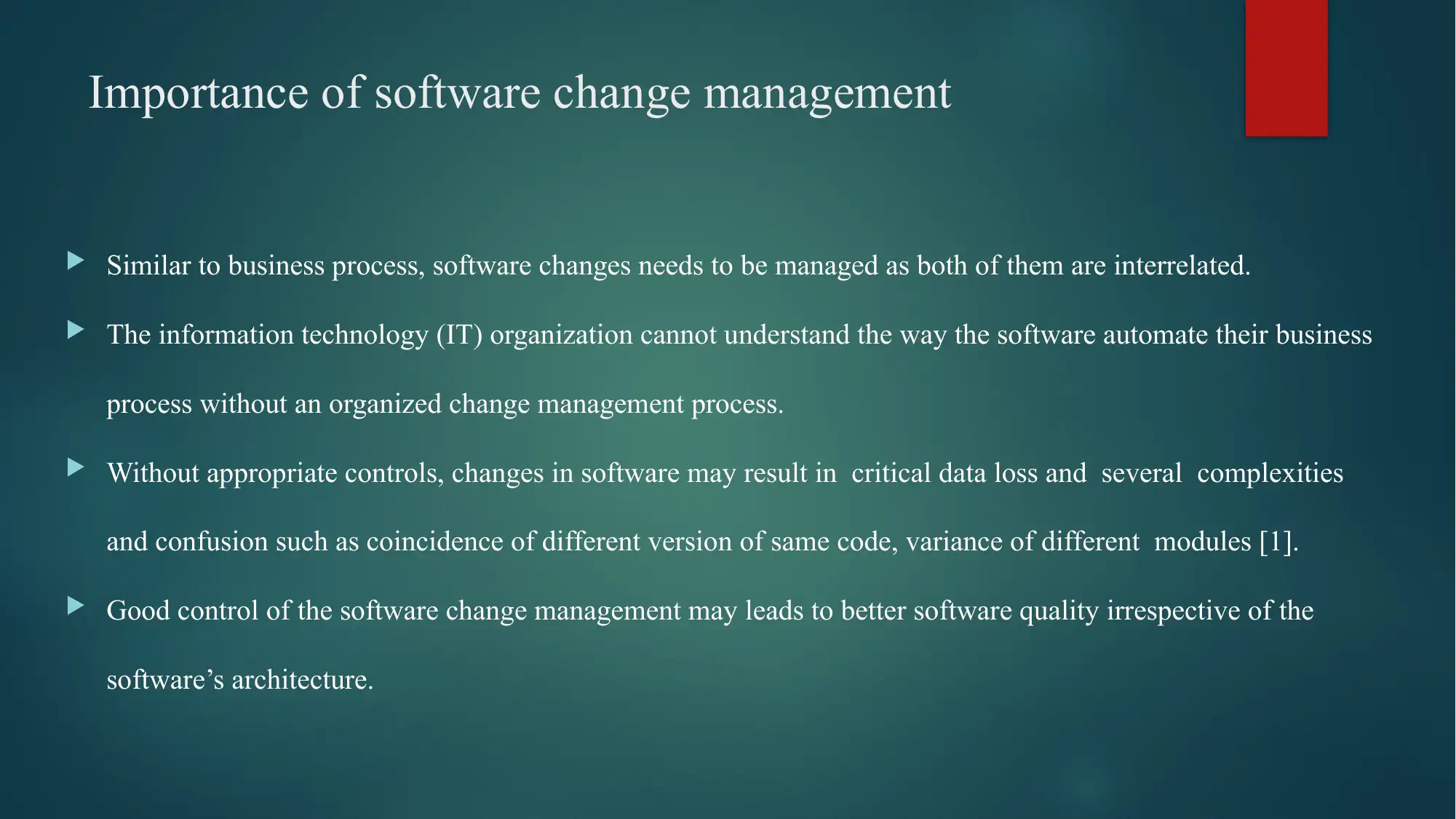
Importance of software change management
Similar to business process, software changes needs to be managed as both of them are interrelated.
The information technology (IT) organization cannot understand the way the software automate their business
process without an organized change management process.
Without appropriate controls, changes in software may result in critical data loss and several complexities
and confusion such as coincidence of different version of same code, variance of different modules [1].
Good control of the software change management may leads to better software quality irrespective of the
software’s architecture.
Similar to business process, software changes needs to be managed as both of them are interrelated.
The information technology (IT) organization cannot understand the way the software automate their business
process without an organized change management process.
Without appropriate controls, changes in software may result in critical data loss and several complexities
and confusion such as coincidence of different version of same code, variance of different modules [1].
Good control of the software change management may leads to better software quality irrespective of the
software’s architecture.
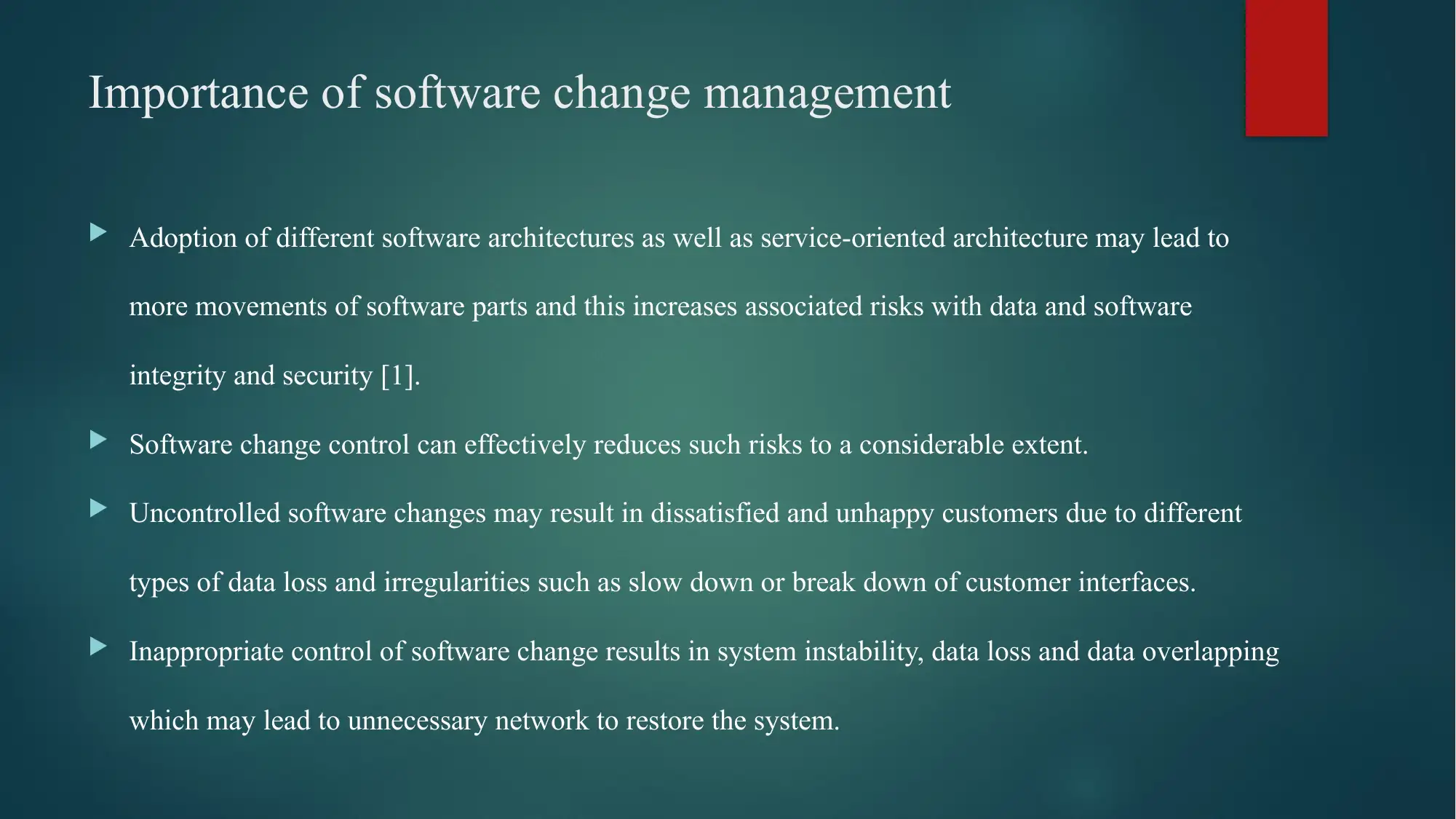
Importance of software change management
Adoption of different software architectures as well as service-oriented architecture may lead to
more movements of software parts and this increases associated risks with data and software
integrity and security [1].
Software change control can effectively reduces such risks to a considerable extent.
Uncontrolled software changes may result in dissatisfied and unhappy customers due to different
types of data loss and irregularities such as slow down or break down of customer interfaces.
Inappropriate control of software change results in system instability, data loss and data overlapping
which may lead to unnecessary network to restore the system.
Adoption of different software architectures as well as service-oriented architecture may lead to
more movements of software parts and this increases associated risks with data and software
integrity and security [1].
Software change control can effectively reduces such risks to a considerable extent.
Uncontrolled software changes may result in dissatisfied and unhappy customers due to different
types of data loss and irregularities such as slow down or break down of customer interfaces.
Inappropriate control of software change results in system instability, data loss and data overlapping
which may lead to unnecessary network to restore the system.
⊘ This is a preview!⊘
Do you want full access?
Subscribe today to unlock all pages.

Trusted by 1+ million students worldwide
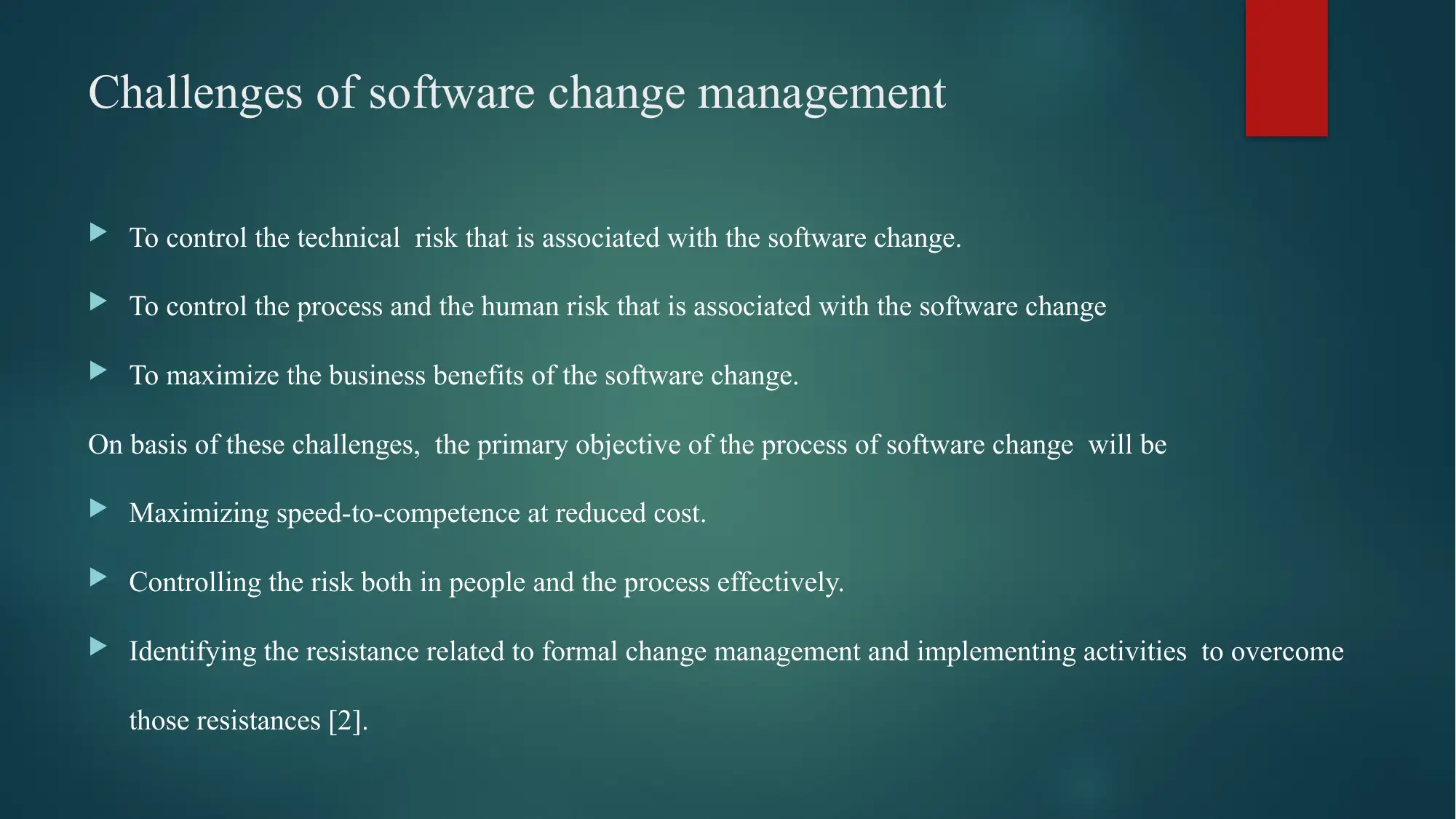
Challenges of software change management
To control the technical risk that is associated with the software change.
To control the process and the human risk that is associated with the software change
To maximize the business benefits of the software change.
On basis of these challenges, the primary objective of the process of software change will be
Maximizing speed-to-competence at reduced cost.
Controlling the risk both in people and the process effectively.
Identifying the resistance related to formal change management and implementing activities to overcome
those resistances [2].
To control the technical risk that is associated with the software change.
To control the process and the human risk that is associated with the software change
To maximize the business benefits of the software change.
On basis of these challenges, the primary objective of the process of software change will be
Maximizing speed-to-competence at reduced cost.
Controlling the risk both in people and the process effectively.
Identifying the resistance related to formal change management and implementing activities to overcome
those resistances [2].
Paraphrase This Document
Need a fresh take? Get an instant paraphrase of this document with our AI Paraphraser
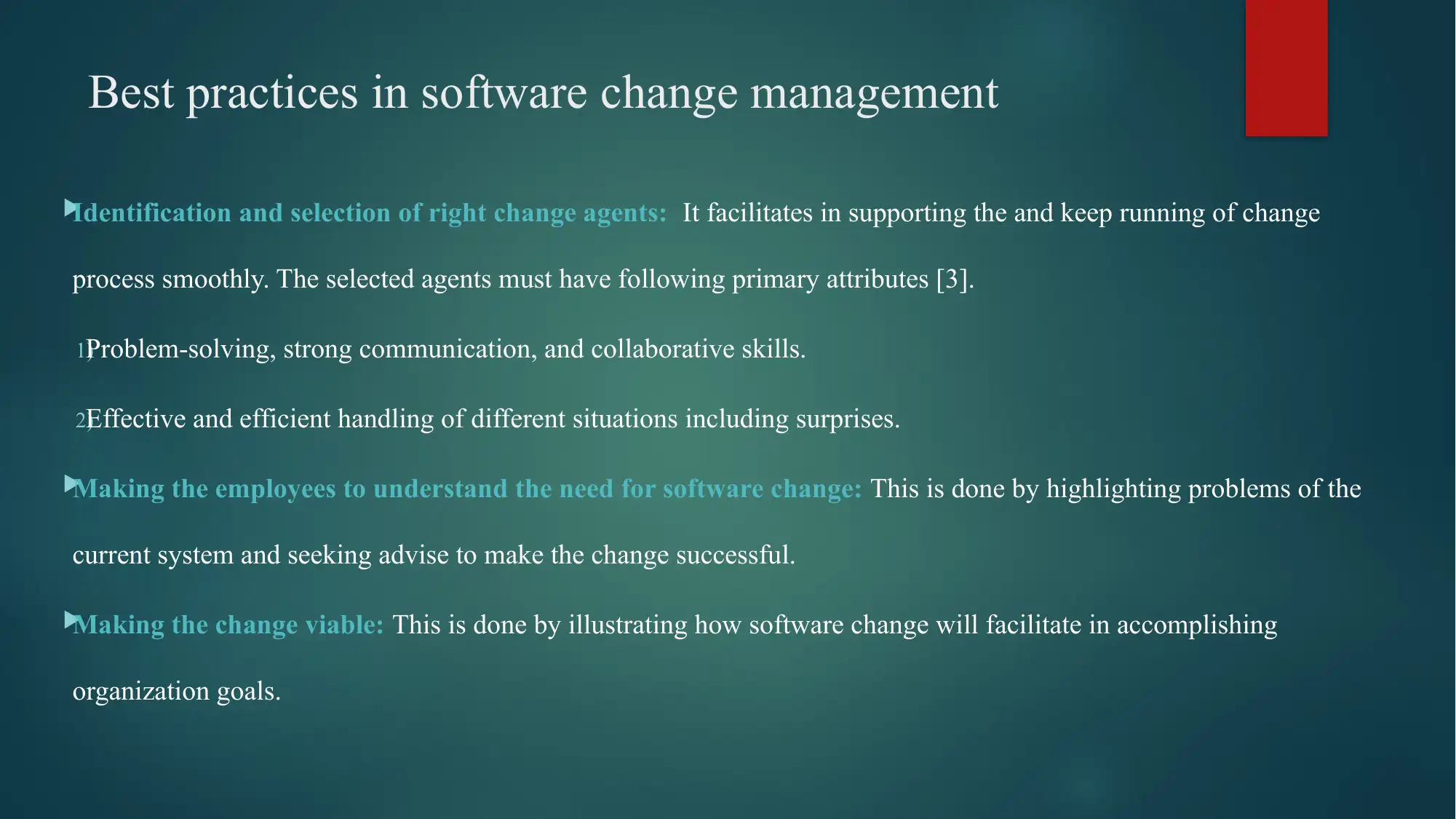
Best practices in software change management
Identification and selection of right change agents: It facilitates in supporting the and keep running of change
process smoothly. The selected agents must have following primary attributes [3].
1)Problem-solving, strong communication, and collaborative skills.
2)Effective and efficient handling of different situations including surprises.
Making the employees to understand the need for software change: This is done by highlighting problems of the
current system and seeking advise to make the change successful.
Making the change viable: This is done by illustrating how software change will facilitate in accomplishing
organization goals.
Identification and selection of right change agents: It facilitates in supporting the and keep running of change
process smoothly. The selected agents must have following primary attributes [3].
1)Problem-solving, strong communication, and collaborative skills.
2)Effective and efficient handling of different situations including surprises.
Making the employees to understand the need for software change: This is done by highlighting problems of the
current system and seeking advise to make the change successful.
Making the change viable: This is done by illustrating how software change will facilitate in accomplishing
organization goals.
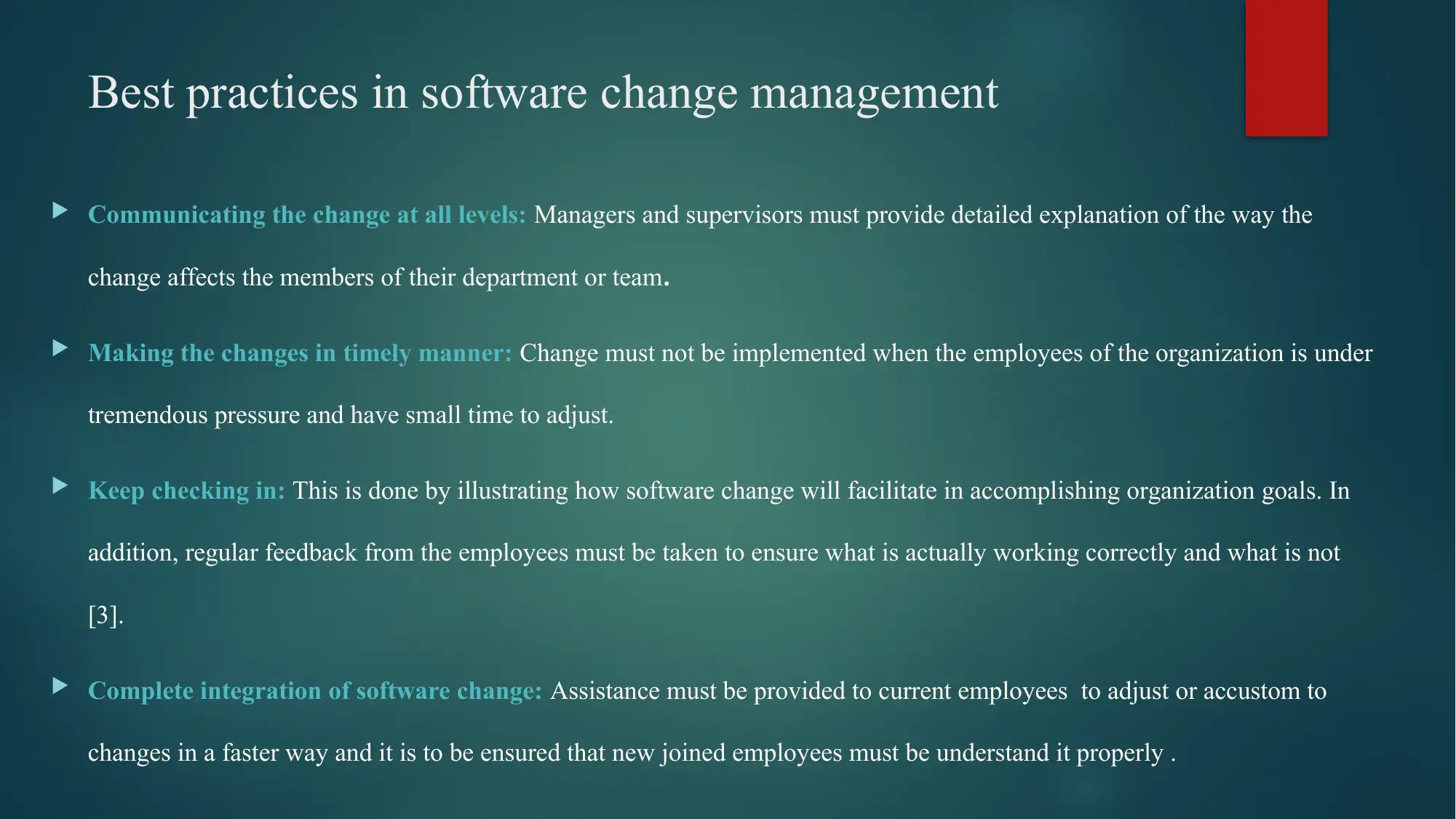
Best practices in software change management
Communicating the change at all levels: Managers and supervisors must provide detailed explanation of the way the
change affects the members of their department or team.
Making the changes in timely manner: Change must not be implemented when the employees of the organization is under
tremendous pressure and have small time to adjust.
Keep checking in: This is done by illustrating how software change will facilitate in accomplishing organization goals. In
addition, regular feedback from the employees must be taken to ensure what is actually working correctly and what is not
[3].
Complete integration of software change: Assistance must be provided to current employees to adjust or accustom to
changes in a faster way and it is to be ensured that new joined employees must be understand it properly .
Communicating the change at all levels: Managers and supervisors must provide detailed explanation of the way the
change affects the members of their department or team.
Making the changes in timely manner: Change must not be implemented when the employees of the organization is under
tremendous pressure and have small time to adjust.
Keep checking in: This is done by illustrating how software change will facilitate in accomplishing organization goals. In
addition, regular feedback from the employees must be taken to ensure what is actually working correctly and what is not
[3].
Complete integration of software change: Assistance must be provided to current employees to adjust or accustom to
changes in a faster way and it is to be ensured that new joined employees must be understand it properly .
⊘ This is a preview!⊘
Do you want full access?
Subscribe today to unlock all pages.

Trusted by 1+ million students worldwide
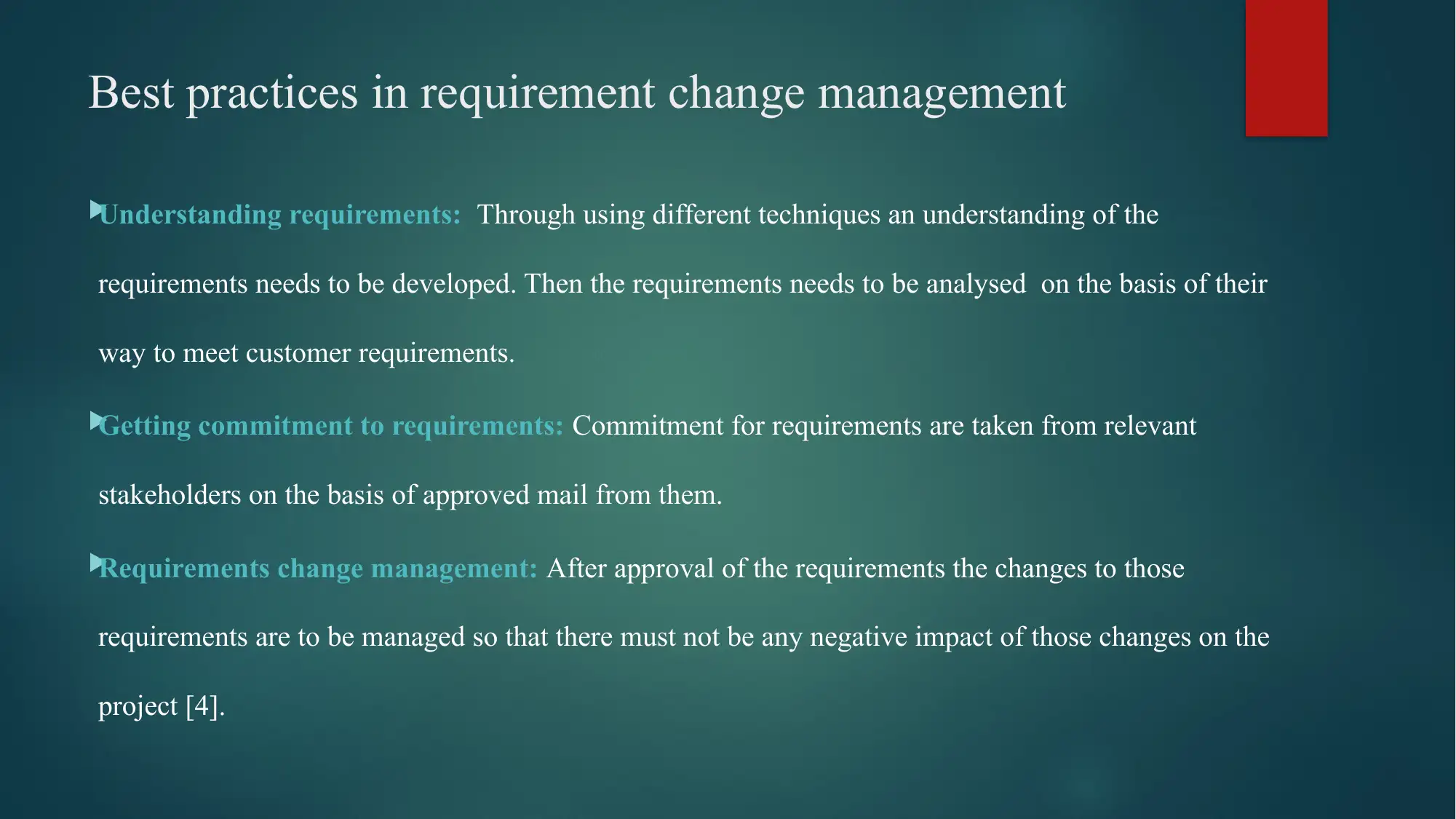
Best practices in requirement change management
Understanding requirements: Through using different techniques an understanding of the
requirements needs to be developed. Then the requirements needs to be analysed on the basis of their
way to meet customer requirements.
Getting commitment to requirements: Commitment for requirements are taken from relevant
stakeholders on the basis of approved mail from them.
Requirements change management: After approval of the requirements the changes to those
requirements are to be managed so that there must not be any negative impact of those changes on the
project [4].
Understanding requirements: Through using different techniques an understanding of the
requirements needs to be developed. Then the requirements needs to be analysed on the basis of their
way to meet customer requirements.
Getting commitment to requirements: Commitment for requirements are taken from relevant
stakeholders on the basis of approved mail from them.
Requirements change management: After approval of the requirements the changes to those
requirements are to be managed so that there must not be any negative impact of those changes on the
project [4].
Paraphrase This Document
Need a fresh take? Get an instant paraphrase of this document with our AI Paraphraser
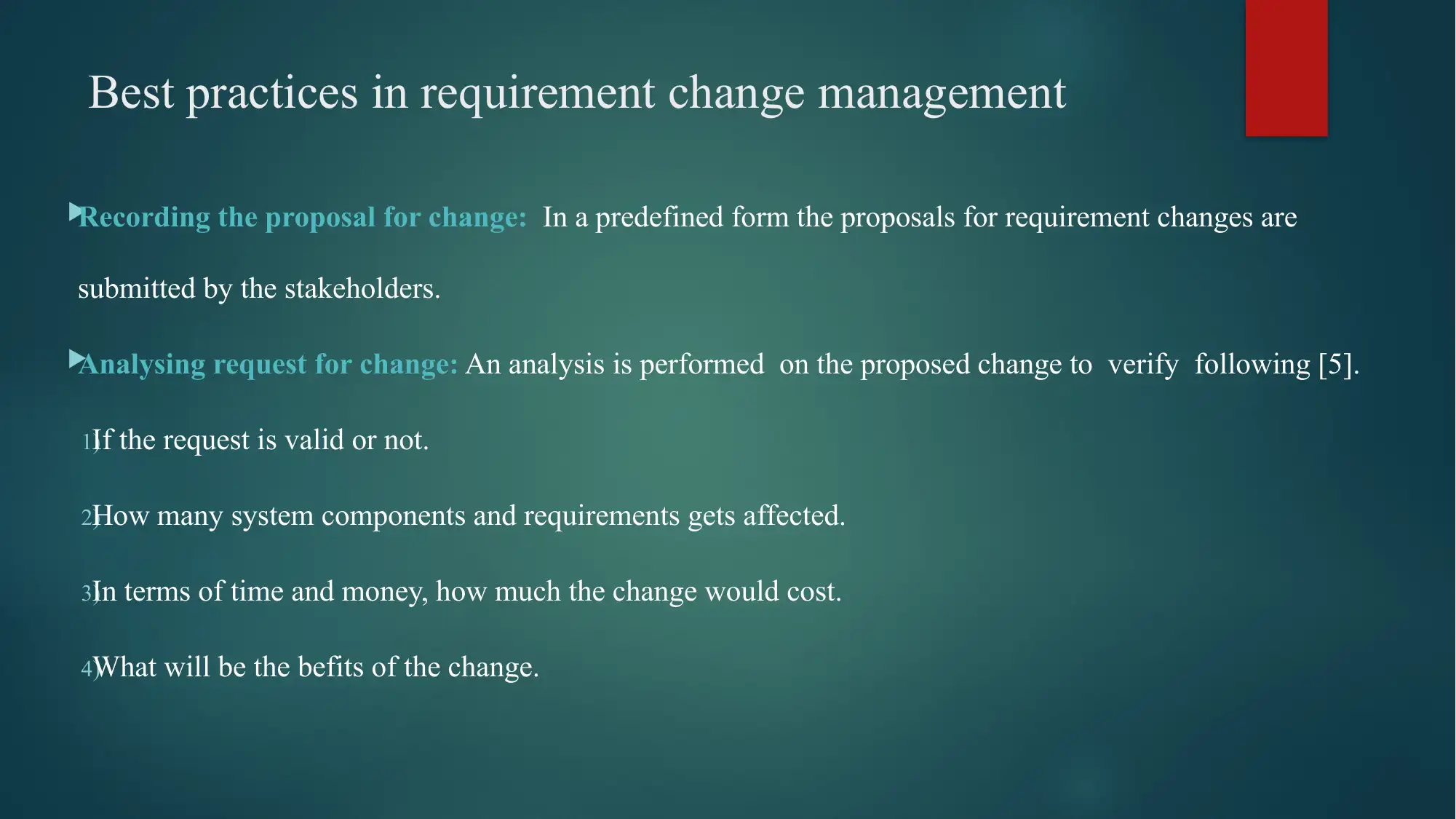
Best practices in requirement change management
Recording the proposal for change: In a predefined form the proposals for requirement changes are
submitted by the stakeholders.
Analysing request for change: An analysis is performed on the proposed change to verify following [5].
1)If the request is valid or not.
2)How many system components and requirements gets affected.
3)In terms of time and money, how much the change would cost.
4)What will be the befits of the change.
Recording the proposal for change: In a predefined form the proposals for requirement changes are
submitted by the stakeholders.
Analysing request for change: An analysis is performed on the proposed change to verify following [5].
1)If the request is valid or not.
2)How many system components and requirements gets affected.
3)In terms of time and money, how much the change would cost.
4)What will be the befits of the change.
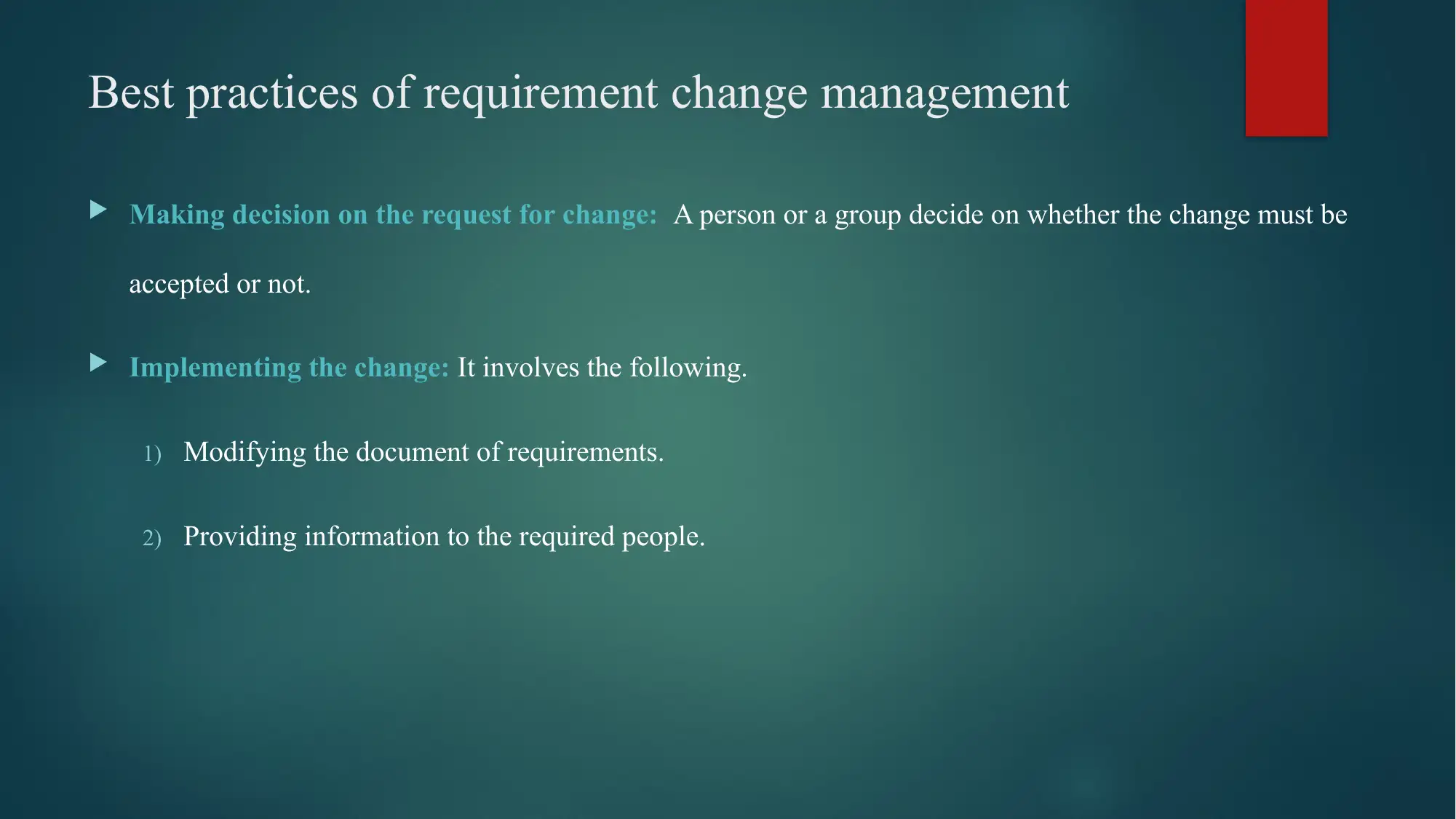
Best practices of requirement change management
Making decision on the request for change: A person or a group decide on whether the change must be
accepted or not.
Implementing the change: It involves the following.
1) Modifying the document of requirements.
2) Providing information to the required people.
Making decision on the request for change: A person or a group decide on whether the change must be
accepted or not.
Implementing the change: It involves the following.
1) Modifying the document of requirements.
2) Providing information to the required people.
⊘ This is a preview!⊘
Do you want full access?
Subscribe today to unlock all pages.

Trusted by 1+ million students worldwide
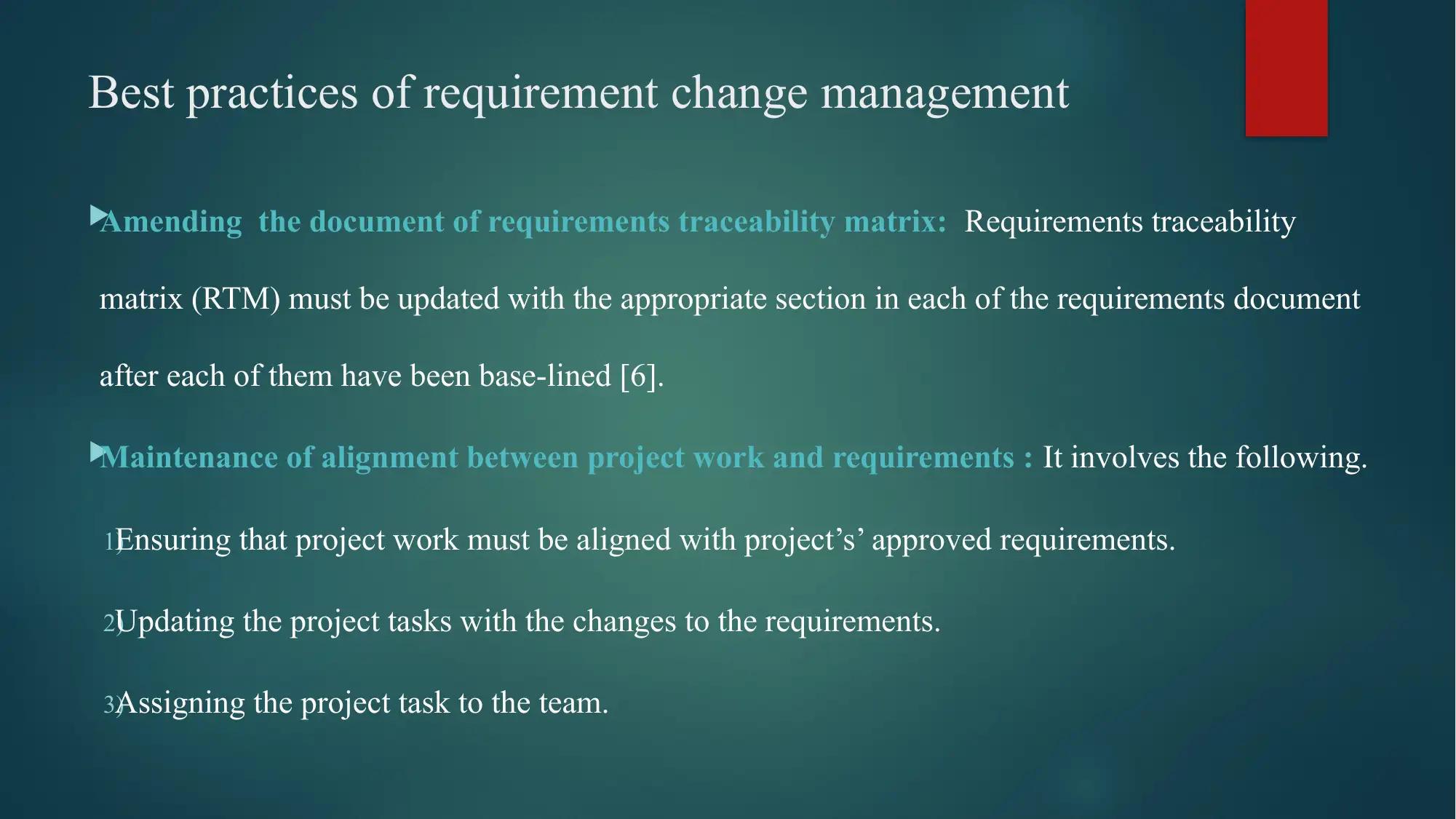
Best practices of requirement change management
Amending the document of requirements traceability matrix: Requirements traceability
matrix (RTM) must be updated with the appropriate section in each of the requirements document
after each of them have been base-lined [6].
Maintenance of alignment between project work and requirements : It involves the following.
1)Ensuring that project work must be aligned with project’s’ approved requirements.
2)Updating the project tasks with the changes to the requirements.
3)Assigning the project task to the team.
Amending the document of requirements traceability matrix: Requirements traceability
matrix (RTM) must be updated with the appropriate section in each of the requirements document
after each of them have been base-lined [6].
Maintenance of alignment between project work and requirements : It involves the following.
1)Ensuring that project work must be aligned with project’s’ approved requirements.
2)Updating the project tasks with the changes to the requirements.
3)Assigning the project task to the team.
Paraphrase This Document
Need a fresh take? Get an instant paraphrase of this document with our AI Paraphraser
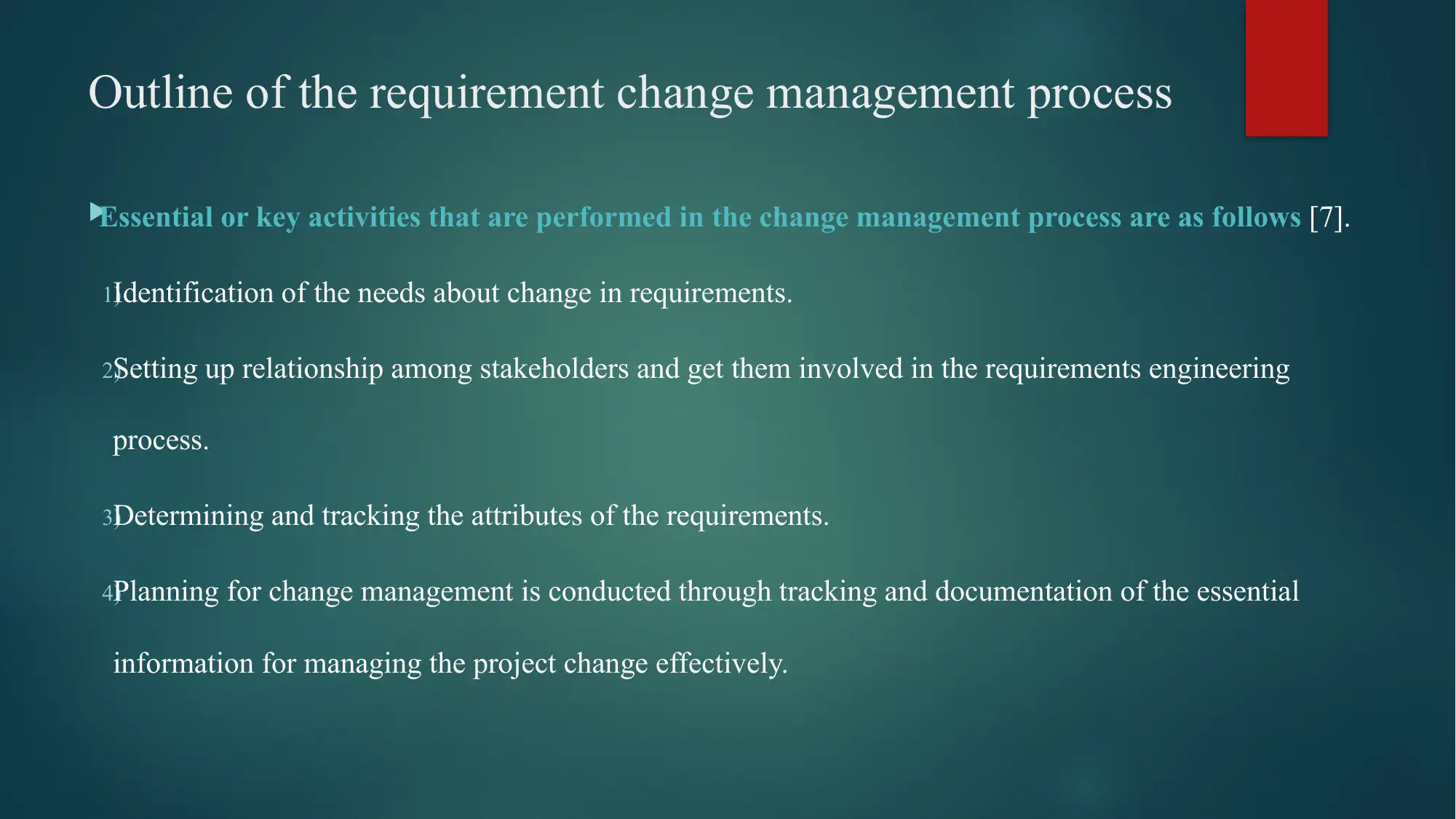
Outline of the requirement change management process
Essential or key activities that are performed in the change management process are as follows [7].
1)Identification of the needs about change in requirements.
2)Setting up relationship among stakeholders and get them involved in the requirements engineering
process.
3)Determining and tracking the attributes of the requirements.
4)Planning for change management is conducted through tracking and documentation of the essential
information for managing the project change effectively.
Essential or key activities that are performed in the change management process are as follows [7].
1)Identification of the needs about change in requirements.
2)Setting up relationship among stakeholders and get them involved in the requirements engineering
process.
3)Determining and tracking the attributes of the requirements.
4)Planning for change management is conducted through tracking and documentation of the essential
information for managing the project change effectively.
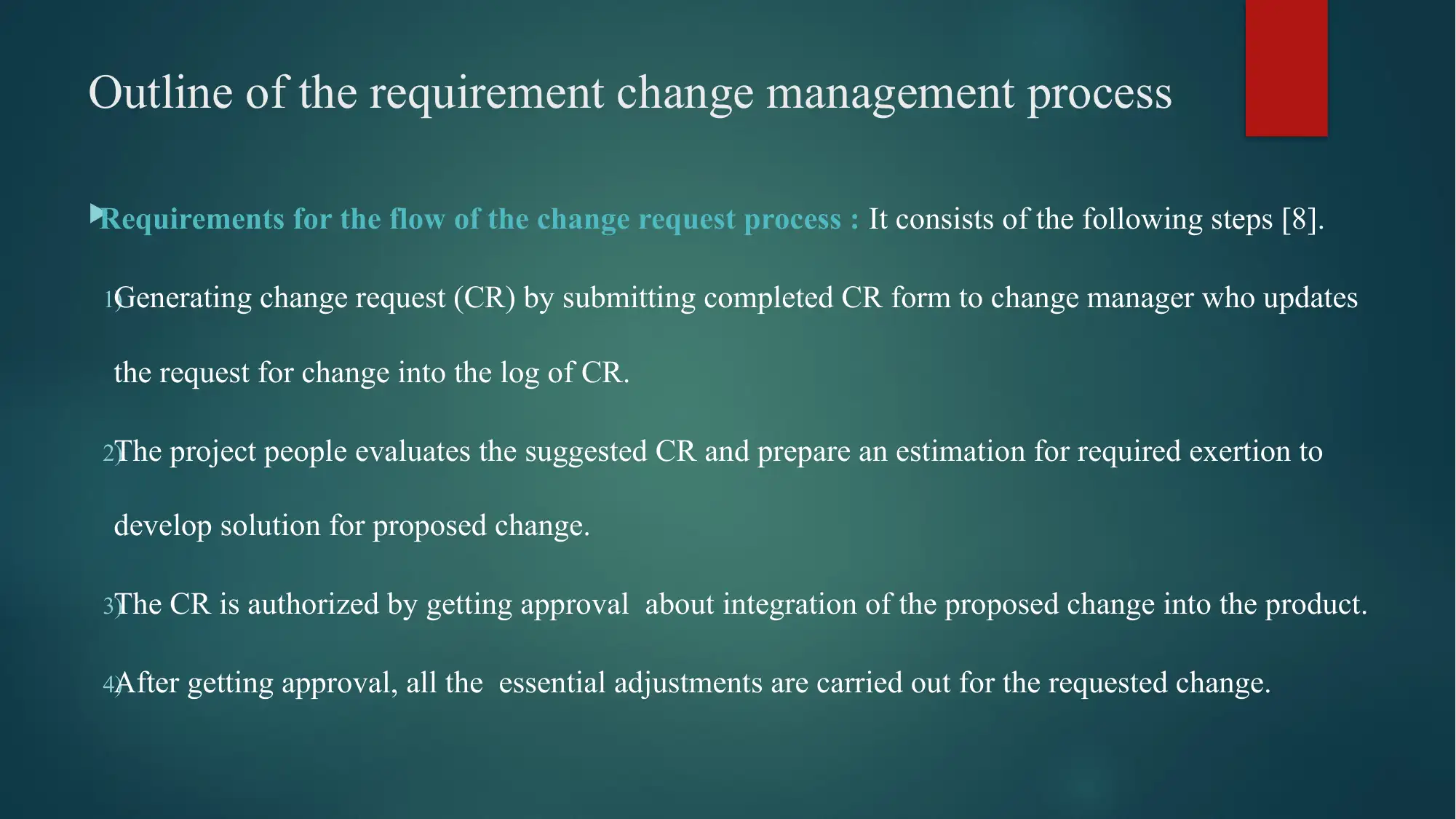
Outline of the requirement change management process
Requirements for the flow of the change request process : It consists of the following steps [8].
1)Generating change request (CR) by submitting completed CR form to change manager who updates
the request for change into the log of CR.
2)The project people evaluates the suggested CR and prepare an estimation for required exertion to
develop solution for proposed change.
3)The CR is authorized by getting approval about integration of the proposed change into the product.
4)After getting approval, all the essential adjustments are carried out for the requested change.
Requirements for the flow of the change request process : It consists of the following steps [8].
1)Generating change request (CR) by submitting completed CR form to change manager who updates
the request for change into the log of CR.
2)The project people evaluates the suggested CR and prepare an estimation for required exertion to
develop solution for proposed change.
3)The CR is authorized by getting approval about integration of the proposed change into the product.
4)After getting approval, all the essential adjustments are carried out for the requested change.
⊘ This is a preview!⊘
Do you want full access?
Subscribe today to unlock all pages.

Trusted by 1+ million students worldwide
1 out of 23
Related Documents
Your All-in-One AI-Powered Toolkit for Academic Success.
+13062052269
info@desklib.com
Available 24*7 on WhatsApp / Email
![[object Object]](/_next/static/media/star-bottom.7253800d.svg)
Unlock your academic potential
Copyright © 2020–2026 A2Z Services. All Rights Reserved. Developed and managed by ZUCOL.





